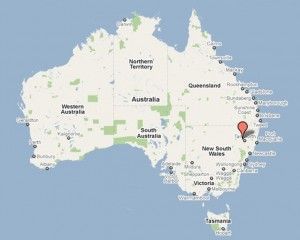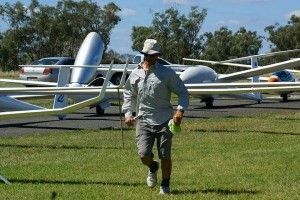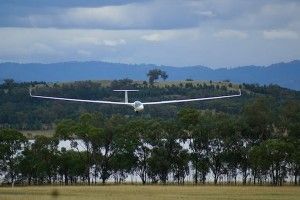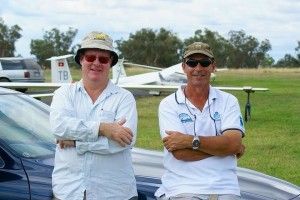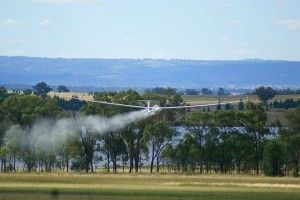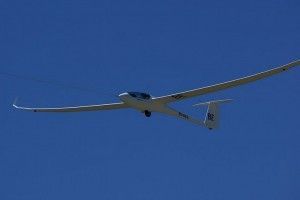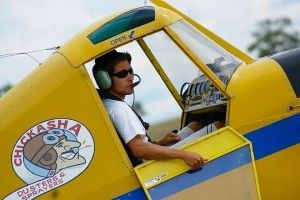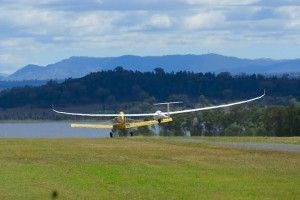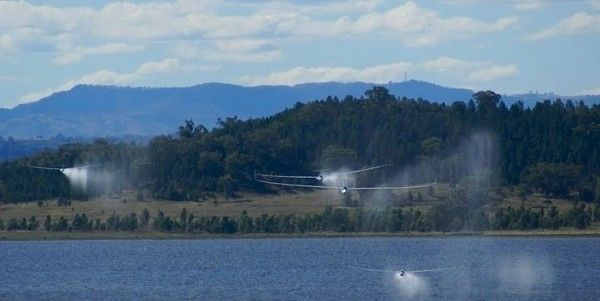The [2011] Aussie GP Qualifier has just been completed at Lake Keepit, in North-Eastern New South Wales. Originally this event was scheduled for Boonah, which is a small club in the South-East of Queensland, but as many would be aware that part of the world has been swamped with huge rainfall over the past months, and it was decided to move the competition further south. It was originally planned to fly this comp in Standard class, but that was also changed to the 18m class, as the majority of the would-be participants were owners of 18m gliders.
The aircraft included a big group of ASG 29s, plus the two JS1s that now live here (one of which is mine) and also a Nimbus 3DM which flew hors concours for the fun of it. After the ridiculously wet season we have had here, it was my first chance to compare the ’29 to the JS1 in some real weather. Two of the ‘29s were flown by David Jansen and Graham Parker, our two Aussie representatives for the last couple of world comps in the 18m class, so it was a good comparison.
The flying provided some days of very close racing, and a couple of days where the field was well spread. Given the weather that we experienced, my greatest impression of the JS1 was the advantage it gave me in feel of the air. There were many times when I was able to quickly centre a climb and even show the ‘29s where to go, particularly in overdeveloped conditions with a lot of spreadout and big areas of lift. Also my impression is that the JS1 climbs slightly better at maximum weight than the others. The ’29 is still very good in the glide, particularly around the high mid-range speeds of 80 to 100 knots, but overall I certainly felt that I had an advantage.
The competition began with me arriving in a rush early on day one. My youngest son had held a 21st birthday party the night before, and of course there were duties to perform. So the time before launch was insane; rig, set the task, tape, ballast, get to briefing, weigh, get on the grid, and finally sit quietly in my car for five minutes while I ate my lunch. My hectic arrival probably had much to do with me messing up the start entirely. I have a lot of experience at GP starts, but I arrived at the line way too high and early, and had to pull a desperate sideslip at the last second to get under the line below the speed limit. What a circus! I was awarded a penalty for my efforts – rather embarrassing!
Most of the flight proceeded as planned, except for the northern turn which was very overdeveloped and weak. We were all down to treetop height working one knotters, with the sun disappearing to the south just slightly faster than we could chase it! We travelled as a group, but getting closer to home I left a climb early with the range to reach a more solid cloud in the first real sunshine, and was surprised to see that the others chose a different direction.
I was rewarded with a solid four knot climb, then found a seven knotter which topped out a thousand feet short of final glide, with little obvious sign of lift between there and Lake Keepit. By choosing my path home carefully I made up the deficit and finished with a healthy gap back to Tom Claffey. This gave me a day win, which was a huge surprise after the traumatic beginning.
The next day was cancelled in the air, due to high overcast and very slow heating. Graham Parker and I decided to attempt the task. Initially we started separately, but came together at the first turn under a really gloomy sky. From this point on I was certain that I wasn’t coming home. We tracked towards the second turn, where it was about to rain, and were surprised by enough weak climbs to get in and out. But now it was starting to rain everywhere, and each climb was certainly our last as we headed for every slightly brighter patch on the ground. Company was a huge help. Then out of the darkness came the hint perhaps of a weak street pointing halfway between the final turn and home. We dribbled along it with a few careful turns, until we could just glide home. At this stage the final turn was in heavy rain, and we agreed that we’d pushed our luck far enough and crawled back to Keepit. It was a really interesting flight for both of us.
The next day was my worst result – 6th place. It was one of those days when you just don’t get up and running. There were six knotters around, and I seemed to only be able to find four, except for the last climb of the day, but by then (in GP land) it was too late. Once again we had very moist air to fly in, and it was David Jansen who made the most of it and took the day win.
For day three we thought the weather might be a little easier to pick, but once again there was an unexpectedly large amount of moisture coming into the area. As task setter I was keen to go somewhere new and to head north, but as launch time approached it became obvious that we still had to go south-west. The northern area had some high cloud and the sky just looked wet and soggy. Today we threw in a bonus point for the first turn, which was about 35 km from the start.
The start was difficult as the sky cycled just before we were due to get behind the line. This left everybody scrambling to maintain height until start time, and I think most of us left a bit low. Everyone had the bonus point on their mind, but it was difficult to get up and running and I don’t think any of us were in a big hurry to dive down to treetop height with a good chance of outlanding just for one point. I lucked out with a surprising 6 knot climb that opened up the opportunity to sneak in for the bonus, followed by flying sweetly into a solid climb straight afterwards. Some days things just work that way!
We all rolled over one another down the first leg, with some slow, difficult patches interspersed with the odd strong climb. Down at the second turn there was a lot of overdevelopment, and you needed to be patient and careful. Around the turn, and amongst most of the crowd, I found a good bubble and pulled away from them before everyone joined. This was a fine example of the flying qualities of the JS1, as we were all milling around looking for a climb, and the superb feel gave me the edge. This gave me a slight lead which I managed to keep all the way home. As we moved north to the final turn the conditions improved, and I found some great runs between the climbs, which by this time were often 7 knots. I saw Brad Edwards (in the other JS1) here, but just far enough behind that I felt comfortable with my lead. After that it was a fast run home under some reliable clouds.
Day four was certainly my most satisfying, but what a day of ups and downs! It was windy, and pre-start the climbs were slow and showed signs of being broken and sometimes difficult to work. Tom Claffey found quite good wave while we were waiting to go too – testament to the strong winds up high. Finally today the task was to the north, via a bonus point turn, then east and home.
The start was messy, with some timing issues, the wind and unpredictable thermal conditions all conspiring to complicate the process. Some of the group crossed the line to the west and connected immediately with strong climbs to get up and running. Graham Parker and I were left struggling, and flew down to about 1500 feet before we finally found something going up. Obviously neither of us was even close enough to see who won the bonus point, but heard that it was David Jansen.
Then I flew off along the high ground that leads up to Mount Kaputar, which I know full well never works early in the afternoon… and of course today was no exception, it still wasn’t working! All of this meant that by the time the fast guys had turned the northern turn I was about 15km behind, and feeling decidedly out-of-sync with the weather.
Brad Edwards and I were together here and we eventually found a decent climb and were joined by Graham again, only to see the gaggle ahead pull into a monster climb a bit south of our track. At least now we could see how far ahead they were! Out here on the plains the thermals felt better organised, and I worked hard at telling myself that I needed to relax, keep doing my best and that maybe my chance would come – there was still plenty of flying to do before home.
I tagged along around the final turn, knowing that if I continued “tagging along” I would finish the same distance behind as I currently was, about 12 – 15 km back. Shortly after the turn I watched the gaggle track almost directly for Keepit, but there was a promising cloud some distance off to the right that I gambled would give a strong climb. It did. A solid 7 knots gave me the jump I needed, followed by a nice run in buoyant air to meet up with the front runners about 50 km out from home. This area was difficult again, surrounded by hills and turbulence in the wind, and I picked a couple of scrappy climbs but kept pressing on towards a better looking sky ahead.
Eventually with about 600 feet to make up I set off for home, and the sky was as good as it looked. I made up the deficit plus some more, and had a fast run back to finish just ahead of Graham. That was very pleasing, to go from dead last to first and second. We couldn’t believe our luck! It was fun to go north for a change of scenery too.
On the final day the weather looked the best of the week, and I set a task to the north-west, in tune with my aim of varying the task area as much as possible. What a great race this turned out to be! It was blowing pretty hard with some significant streeting straight out on the first leg. I had an early launch and used the time to play with the building lines of lift. There was another bonus point for the first turn, but this time it was 60 km out from the start.
I ran through the northern end of the start line and hooked onto the highway I had been watching. Despite the 3,000 foot start I soon found I was gaining height without stopping. It was a fantastic run, and I swooped around the first turn well ahead of the crowd, with an achieved glide angle of well over 1000:1 for the leg! From there I was frustrated by the wind and some broken climbs, until the crowd caught me again, but at this stage I was happy to have the company.
From there until the end of the task it was an out-and-out race. We swapped the lead constantly. The third leg was low over wet ground, but then came good for the final two legs, which were quite fast in improving conditions. I tried to stay in touch with the lead, but about 50 km out from Lake Keepit I was in fourth place, as far as I could see. What could I do to gain ground? Graham Parker was out the front and driving hard for home, and there were three others above and just behind me. On final glide now there were limited options, but I worked really hard at choosing the best line. About 15km from home I had drawn level with Graham, but was now well out to his right, and I had no idea where the others were. As I headed for the final 10km checkpoint I ran through some bad air for just a few seconds, and it looked like Graham found something better. It was all over! At this range I wasn’t going to make up the lost ground, and Graham was not going to give it away.
We smoked over the line; all five of us line astern and separated by only a few hundred metres. I was second for the day, and a really satisfying first overall. After a couple of years feeling just a little out-of-sorts with my flying, the JS1 is helping me to regain my confidence. The more I fly this glider, the more I love it.
And the Grand Prix? What a fantastic format this is. It is really a racing style that I call, “no bullshit”. No start gate games, very little gaggling, and no waiting to see who has won the day. Simple and fun.

